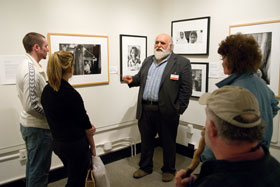  |
| HOME | THIS ISSUE | CALENDAR | GRANTS | BACK ISSUES | < BACK | NEXT > |
Scalora ends Benton Museum tenure with vision realizedby Sherry Fisher - June 19, 2006 |
||||
|
All eyes are fixed on a photograph of a small child sitting in a fly-infested county dump in Jakarta, Indonesia. She is crying. Her mother, a figure in the distance, sifts through the garbage for food. “Three thousand people try to live off this dump,” says Sal Scalora, director of the William Benton Museum of Art, addressing a group of visitors to the gallery. The museum tour is part of the freshmen orientation program and those now visiting are parents of incoming freshmen. “Imagine a mound of ants in a pile of garbage, 3,000 of them, 24 hours a day,” Scalora adds. “At night they strap flashlights on their caps. They step on glass and rusty nails. It’s a nightmare.” The picture isn’t pretty, but that’s the point. Scalora wants viewers to be moved by the works in the Human Rights Gallery. Adding the gallery, he says, “was one of the most exciting things I was able to do during my nine years as director. It established the museum as having a social consciousness.” Scalora, who will retire at the end of the month, was moving the museum in that direction from the minute he took its reins. “I looked at all the wonderful human rights programs at the University and the involvement of faculty and students and I said to myself, ‘What’s missing is the visual component’,” he says. “I knew that when you have a visual image, it hits you like nothing else,” Scalora says. “It goes into your blood stream and brain right away. You get it. We had the Cambodian ‘killing fields’ photographs on exhibit here five years ago, and people wept.” A lecture by Dith Pran, who survived the atrocities, drew a crowd of 500 to the University. The talk was given in cooperation with the Asian American Cultural Center. “For students to see the photographs and hear this living legend talking about his experiences in a death camp was incredible,” Scalora says. These early successes in programming gave Scalora even more confidence that the dream of a human rights gallery would become a reality. “Professors started to send their students over here,” he says. “I saw that we could actually work with faculty and students to provide a very interesting environment that was art-related, but was really about global issues, social consciousness, and justice.” Before the renovation, the museum was a secret to many people, Scalora says.
“Now we have the banners, the new building, the café, and we’re on the quadrangle. Identity change, shifting the graphics – I think all of that has made the Benton a special place.” Having Tibetan monks four years in a row creating sand mandalas brought unprecedented numbers of people to the Benton. “You have to serve the community,” Scalora says. “That’s the role of a University art museum. “Our first responsibility is to be part of the educational process,” he adds. “Now it is really tied into studies. We have moved beyond art as just appreciation.” The exhibit Metamorphosis, which runs through Aug. 6, is in the main gallery. It illustrates the development of the museum’s collection during the past nine years. Scalora selected the 65 pieces on display from 6,000 in the Benton’s permanent collection. “These are like my greatest hits,” says Scalora, who during his tenure added some 1,000 works to the collection, many of them with multicultural themes. “I knew from the onset of my tenure that I wanted to add contemporary art by multicultural artists, and to add more photography to the permanent collection,” he says. “I wanted the collections to be more responsive to the conditions in the world. I felt that anybody should be able to come here and be able to see their values and their culture. So I was very fortunate to get some important pieces by prominent artists.” Scalora purchased pieces from limited endowment funds and started a program, the Medici Circle Artists, in which he asked artists to donate artworks to the Benton collection. Los Angeles photographer James Fee, whose photographs are on display in Metamorphosis, donated some 200 works. “I hope I’ve helped convey that the museum is not just for art lovers,” Scalora says. “It’s about the world. It’s about the global economy. It’s about finding out what your values are. Then you’re ready to go out into the world and face any situation, because you have become a caring humanist.” |
| ADVANCE HOME UCONN HOME |

